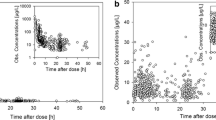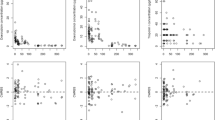Abstract
Purpose
The aim of the current investigation was to develop a population pharmacokinetic model for doxorubicin and doxorubicinol that could provide improved estimated values for the pharmacokinetic parameters clearance of doxorubicin, volume of distribution of the central compartment, clearance of doxorubicinol and volume of distribution of the metabolite compartment for adults and children older than 3 years. A further aim was to investigate the potential influence of the covariates body surface area, body weight, body height, age, body mass index, sex and lean body mass on the pharmacokinetic parameters.
Methods
Three different datasets, two containing data from adults and one containing data from adults and children, were merged and the combined dataset was analysed retrospectively. In total, the combined dataset contained 934 doxorubicin and 935 doxorubicinol plasma concentrations from 82 patients [64 adults and 18 children (<18 years)]. With this combined dataset, a population pharmacokinetic model was developed, using NONMEM® 7.2 and a predefined model-building strategy. Different structural models, error models and estimation methods were tested, and the inter-individual and the inter-occasion variability (variability between separate (two or three) doxorubicin infusions) were tested. Using a subset of 52 patients, the influence of different covariates on the pharmacokinetic parameters was investigated. The pharmacokinetic parameter estimates obtained from doxorubicin concentrations with the best model were fixed, and an additional compartment for doxorubicinol was added to the model. With the final model for both substances, a potential age dependency and body mass index dependency of the clearance of doxorubicin and doxorubicinol as well as of the volumes of distribution of the central and the metabolite compartment were evaluated.
Results
A four-compartment model best described the doxorubicin and doxorubicinol data of the combined dataset. This model included a proportional residual error model and an inter-individual variability on the clearance of doxorubicin, on the inter-compartmental clearances of the peripheral compartments, on the clearance of doxorubicinol and on the volumes of distribution of the central, one peripheral and the metabolite compartment. Furthermore, the body surface area as covariate on all pharmacokinetic parameters and an inter-occasion variability for the clearance of doxorubicin and the volume of distribution of the central compartment were incorporated in the model. For a patient with the body surface area of 1.8 m², the clearance of doxorubicin was 53.3 L/h (inter-individual variability 31 %, inter-occasion variability 13 %) and the volume of distribution of the central compartment was 17.7 L (inter-individual variability 19 %, inter-occasion variability 21 %), respectively. The residual variability of the model was 22 % for doxorubicin and 26 % for doxorubicinol. The clearance of doxorubicinol was estimated at 44 L/h (inter-individual variability 50 %) and the volume of distribution of the metabolite compartment at 1,150 L (inter-individual variability 57 %). The evaluation of a possible age dependency and body mass index dependency showed a trend to a smaller volume of distribution of the central compartment (normalised to the body surface area) and a higher volume of distribution of the metabolite compartment (normalised to the body weight) in younger patients.
Conclusions
A four-compartment NONMEM® model for doxorubicin and doxorubicinol adequately described the plasma concentrations in adults and children (>3 years). No pronounced effects of age on the clearance of doxorubicin or doxorubicinol were found, and the analysis did not support the modification of the dosing strategies presently used in children and adults.






Similar content being viewed by others
Abbreviations
- CL:
-
Clearance
- CWRES:
-
Conditional weighted residuals
- dox’ol:
-
Doxorubicinol
- h:
-
Hour
- kg:
-
Kilogram
- L:
-
Litre
- min:
-
Minute
- OFV:
-
Objective function value
References
Abdi H (2007) Bonferroni and Šidák corrections for multiple comparisons. http://www.utdallas.edu/~herve/Abdi-Bonferroni2007-pretty.pdf. Accessed July 2012
Benjamin RS, Riggs CE Jr, Bachur NR (1977) Plasma pharmacokinetics of adriamycin and its metabolites in humans with normal hepatic and renal function. Cancer Res 37:1416–1420
Blum RH, Carter SK (1974) Adriamycin. A new anticancer drug with significant clinical activity. Ann Intern Med 80:249–259
Bühl A (2008) SPSS 16—Einführung in die moderne Datenanalyse (Statistiken für Kreuztabellen). http://books.google.de/books?id=nkzp6gn--dUC&pg=PA269&lpg=PA269&dq=hohe+geringe+keine+korrelation+spss&source=bl&ots=k1GJ565ETk&sig=qI4oLsUmyWUbJEYtWLtETVuNKCk&hl=de&sa=X&ei=n1LtUIzMEdHotQbwpoDwDA&ved=0CEYQ6AEwAw#v=onepage&q=hohe%20geringe%20keine%20korrelation%20spss&f=false. Accessed July 2012
Callies S, de Alwis DP, Wright JG, Sandler A, Burgess M, Aarons L (2003) A population pharmacokinetic model for doxorubicin and doxorubicinol in the presence of a novel MDR modulator, zosuquidar trihydrochloride (LY335979). Cancer Chemother Pharmacol 51:107–118
Crom R, Green Hayes (1983) Doxorubicin disposition in children and adolescents with cancer. Drug Intell Clin Pharm 17:448
Del Tacca M, Danesi R, Ducci M, Bernardini C, Romanini A (1985) Might adriamycinol contribute to adriamycin-induced cardiotoxicity? Pharmacol Res Commun 17:1073–1084
Eksborg S, Palm C, Bjork O (2000) A comparative pharmacokinetic study of doxorubicin and 4′-epi-doxorubicin in children with acute lymphocytic leukemia using a limited sampling procedure. Anticancer Drugs 11:129–136
Eksborg S, Strandler HS, Edsmyr F, Naslund I, Tahvanainen P (1985) Pharmacokinetic study of i.v. infusions of adriamycin. Eur J Clin Pharmacol 28:205–212
Ette EI, Williams PJ, Kim YH, Lane JR, Liu MJ, Capparelli EV (2003) Model appropriateness and population pharmacokinetic modeling. J Clin Pharmacol 43:610–623
Evans WE, Crom WR, Sinkule JA, Yee GC, Stewart CF, Hutson PR (1983) Pharmacokinetics of anticancer drugs in children. Drug Metab Rev 14:847–886
Fachinformation-Doxorubicin (2008) http://www.fachinfo.de/data/fi/jsearch?wirkstoff (search term: Doxorubicin). Accessed July 2012
Fan L, Goh BC, Wong CI, Sukri N, Lim SE, Tan SH, Guo JY, Lim R, Yap HL, Khoo YM, Iau P, Lee HS, Lee SC (2008) Genotype of human carbonyl reductase CBR3 correlates with doxorubicin disposition and toxicity. Pharmacogenet Genomics 18:621–631
Frost BM, Eksborg S, Bjork O, Abrahamsson J, Behrendtz M, Castor A, Forestier E, Lonnerholm G (2002) Pharmacokinetics of doxorubicin in children with acute lymphoblastic leukemia: multi-institutional collaborative study. Med Pediatr Oncol 38:329–337
Gewirtz DA (1999) A critical evaluation of the mechanisms of action proposed for the antitumor effects of the anthracycline antibiotics adriamycin and daunorubicin. Biochem Pharmacol 57:727–741
Gil P, Favre R, Durand A, Iliadis A, Cano JP, Carcassone Y (1982) Time dependency of adriamycin. Bull Cancer 69:58
Hempel G, Flege S, Wurthwein G, Boos J (2002) Peak plasma concentrations of doxorubicin in children with acute lymphoblastic leukemia or non-Hodgkin lymphoma. Cancer Chemother Pharmacol 49:133–141
Joerger M, Huitema AD, Meenhorst PL, Schellens JH, Beijnen JH (2005) Pharmacokinetics of low-dose doxorubicin and metabolites in patients with AIDS-related Kaposi sarcoma. Cancer Chemother Pharmacol 55:488–496
Joerger M, Huitema AD, Richel DJ, Dittrich C, Pavlidis N, Briasoulis E, Vermorken JB, Strocchi E, Martoni A, Sorio R, Sleeboom HP, Izquierdo MA, Jodrell DI, Fety R, de Bruijn E, Hempel G, Karlsson M, Tranchand B, Schrijvers AH, Twelves C, Beijnen JH, Schellens JH (2007) Population pharmacokinetics and pharmacodynamics of doxorubicin and cyclophosphamide in breast cancer patients: a study by the EORTC-PAMM-NDDG. Clin Pharmacokinet 46:1051–1068
Jonsson EN, Karlsson MO (1999) Xpose—an S-PLUS based population pharmacokinetic/pharmacodynamic model building aid for NONMEM. Comput Methods Programs Biomed 58:51–64
Keizer RJ, van Benten M, Beijnen JH, Schellens JH, Huitema AD (2011) Pirana and PCluster: a modeling environment and cluster infrastructure for NONMEM. Comput Methods Programs Biomed 101:72–79
Krogh-Madsen M, Bender B, Jensen MK, Nielsen OJ, Friberg LE, Honore PH (2012) Population pharmacokinetics of cytarabine, etoposide, and daunorubicin in the treatment for acute myeloid leukemia. Cancer Chemother Pharmacol 69:1155–1163
Kromeyer-Hauschild K, Wabitsch M, Kunze D, Geller F, Geiß HC, Hesse V, von Hippel A, Jaeger U, Johnsen D, Korte W, Menner K, Müller G, Müller JM, Niemann-Polatus A, Remer T, Schaefer F, Wittchen HU, Zabransky S, Zellner K, Ziegler A, Hebebrand J (2001) Perzentile für den Body-mass-index für das Kindes- und Jugendalter unter Heranziehung verschiedener deutscher Stichproben. Monatsschr Kinderheilkd 149:807–818
Kuffel MJ, Reid JM, Ames MM (1992) Anthracyclines and their C-13 alcohol metabolites: growth inhibition and DNA damage following incubation with human tumor cells in culture. Cancer Chemother Pharmacol 30:51–57
Lindbom L, Pihlgren P, Jonsson EN (2005) PsN-Toolkit–a collection of computer intensive statistical methods for non-linear mixed effect modeling using NONMEM. Comput Methods Programs Biomed 79:241–257
Mandema JW, Verotta D, Sheiner LB (1992) Building population pharmacokinetic–pharmacodynamic models. I. Models for covariate effects. J Pharmacokinet Biopharm 20:511–528
McLeod HL, Relling MV, Crom WR, Silverstein K, Groom S, Rodman JH, Rivera GK, Crist WM, Evans WE (1992) Disposition of antineoplastic agents in the very young child. Br J Cancer Suppl 18:S23–S29
Palle J, Frost BM, Peterson C, Gustafsson G, Hellebostad M, Kanerva J, Schmiegelow K, Lonnerholm G (2006) Doxorubicin pharmacokinetics is correlated to the effect of induction therapy in children with acute myeloid leukemia. Anticancer Drugs 17:385–392
Soper D (2012) A-priori sample size calculator for multiple regression. http://danielsoper.com/statcalc3/calc.aspx?id=1. Accessed July 2012
Takanashi S, Bachur NR (1976) Adriamycin metabolism in man. Evidence from urinary metabolites. Drug Metab Dispos 4:79–87
Thompson PA, Rosner GL, Matthay KK, Moore TB, Bomgaars LR, Ellis KJ, Renbarger J, Berg SL (2009) Impact of body composition on pharmacokinetics of doxorubicin in children: a Glaser Pediatric Research Network study. Cancer Chemother Pharmacol 64:243–251
Thomson-Reuters-Healthcare (2012) MICROMEDEX® 2.0—monograph doxorubicin. http://www.thomsonhc.com/micromedex2/librarian/ND_T/evidencexpert/ND_PR/evidencexpert/CS/A55EFB/ND_AppProduct/evidencexpert/DUPLICATIONSHIELDSYNC/7B06A1/ND_PG/evidencexpert/ND_B/evidencexpert/ND_P/evidencexpert/PFActionId/evidencexpert.IntermediateToFullDocumentLink/docId/0737/contentSetId/31/title/DOXORUBICIN/servicesTitle/DOXORUBICIN. Accessed July 2012
Wang DD, Zhang S (2012) Standardized visual predictive check versus visual predictive check for model evaluation. J Clin Pharmacol 52:39–54
Wilde S, Jetter A, Zaigier M, Rietbrock S, Menzel H, Sieber M, Tesch H, Hempel G, Busse D, Schwab M, Reif S, Jaehde U, Diehl V, Fuhr U (2002) Population pharmacokinetics of cyclophosphamide, doxorubicin and etoposide in 30 patients with BEACOPP chemotherapy. Int J Clin Pharmacol Ther 40:586–588
Acknowledgments
The research leading to these results has received funding from the European Community’s Seventh Framework Programme (FP7/2009-2013) under grant agreement n° 222910. MK and GW are supported by the German Federal Ministry of Research and Education (BMBF grant 01KN1105). We thank Sophie Callies for providing us with the pharmacokinetic raw data.
Conflict of interest
None declared.
Author information
Authors and Affiliations
Corresponding author
Appendix 1: Control stream for the final model
Appendix 1: Control stream for the final model

Rights and permissions
About this article
Cite this article
Kontny, N.E., Würthwein, G., Joachim, B. et al. Population pharmacokinetics of doxorubicin: establishment of a NONMEM model for adults and children older than 3 years. Cancer Chemother Pharmacol 71, 749–763 (2013). https://doi.org/10.1007/s00280-013-2069-1
Received:
Accepted:
Published:
Issue Date:
DOI: https://doi.org/10.1007/s00280-013-2069-1




